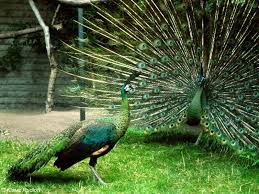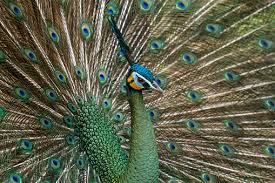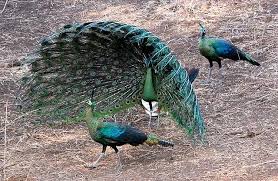The green peafowl (from Latin Pavo, peafowl; muticus, Mute, docked or curtailed) is a species of peafowl that
is found in the tropical forests of Southeast Asia. It is also known as the Java peafowl, but this term is
properly used to describe the nominate subspecies endemic to the island of Java in Indonesia. It is the
closest relative of the Indian peafowl or blue peafowl (Pavo cristatus), which is mostly found on the
Indian subcontinent.
Description

Unlike the related Indian peafowl, the sexes of green peafowl are quite similar in appearance, especially in
the wild. Both sexes have long upper tail coverts which cover the actual tail underneath. In the male this
extends up to two meters and is decorated with eyespots or ocelli while in the female the coverts are green
and much shorter, just covering the tail. Outside the breeding season, however, the male's train is moulted
and it can be difficult to distinguish the sexes unless they are observed up close. The neck and breast
feathers of both sexes are iridescent green and resemble scales. In the male, the scapulars, median and
greater wing coverts are blue while the lesser coverts are green and form a triangle of scaly feathers on
the shoulder when the wing is closed. The secondaries are black and in some subspecies the tertials are
brown and/or barred with a faint pattern. The female has blue lesser coverts and therefore lacks the
triangle at the wing shoulder. Females also have neck scales fringed with copper as well as more barring on
the back as well as the primaries and alula. Both sexes have shafted crests, and are long-legged,
heavy-winged and long-tailed in silhouette. The crest of the female has slightly wider plumes while those of
the male are thinner and taller. The facial skin is double striped with a white to light blue and beside the
ear is a yellow to orange crescent. The dark triangle below the eye towards the eyebrow is bluish-green in
the male and brown in the female. Seen from a distance, they are generally dark coloured birds with pale
vermillion or buff coloured primaries which are quite visible in their peculiar flight which has been
described as a true flapping flight with little gliding that one associates with Galliform birds.
Green peafowl are generally more silent than Indian peafowl. The male of some subspecies, especially
imperator, have a loud call of ki-wao, which is often repeated. The female has a loud aow-aa call with an
emphasis on the first syllable. The male may also make a similar call. The males call from their roost sites
at dawn and dusk.
Green peafowl are large birds, amongst the largest living galliforms in terms of overall size, though rather
lighter-bodied than the wild turkey, and perhaps the longest extant, wild bird in total length. The male is
1.8-3 m (5 ft 11 in-9 ft 10 in) in total length but this includes its tail covert (or "train") which itself
measures 1.4-1.6 m (4 ft 7 in 5 ft 3 in). The tail coverts are even longer than those of the male Indian
peafowl but are shorter than those of the arguses. The adult female is around half the total length of the
breeding male at 1-1.1 m (3 ft 3 in 3 ft 7 in) in length. It has a relatively large wingspan that averages
around 1.2 m (3 ft 11 in) and can reach 1.6 m (5 ft 3 in) in big males. The green peafowl is capable of
sustained flight and is often observed on wing.
Distribution and habitat
The green peafowl was widely distributed in Southeast Asia in the past from eastern and north-eastern India,
northern Myanmar and southern China, extending through Laos, and Thailand into Vietnam, Cambodia, Peninsular
Malaysia and the islands of Java. Records from northeastern India have been questioned and old records are
possibly of feral birds. The ranges have reduced with habitat destruction and hunting.
Green peafowls are found in a wide range of habitats including primary and secondary forest, both tropical
and subtropical, as well as evergreen and deciduous. They may also be found amongst bamboo, on grasslands,
savannas, scrub and farmland edge. In Vietnam, the preferred habitat was found to be dry deciduous forest
close to water and away from human disturbance. Proximity to water appears to be an important factor.
Behavior
The green peafowl is a forest bird which nests on the ground laying 3 to 6 eggs.
It has been widely believed that the green peafowl is polygynous, but unlike the Indian peafowl, males are
solitary and do not display in leks. Instead the solitary males are highly territorial and form harems with
no pair bonds.
However, the theory that the male is polygynous also conflicts with observations in captivity; pairs left
alone with no human interaction have been observed to be strongly monogamous. The close similarity between
both sexes also suggests a different breeding system in contrast to that of the Indian peafowl. Thus, some
authors have suggested that the harems seen in the field are juvenile birds and that males are not
promiscuous.
They usually spend time on or near the ground in tall grasses and sedges. Family units roost in trees at a
height of 10-15 m (33-49 ft). The diet consists mainly of fruits, invertebrates, reptiles, frogs and
rodents. As with the other member of its genus, the green peafowl can even hunt venomous snakes. Ticks and
termites, flower petals, buds leaves and berries are favorite foods of adult peafowl.








